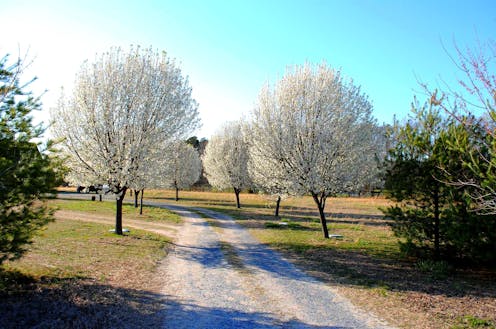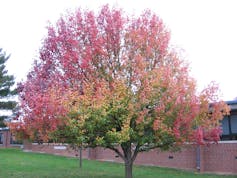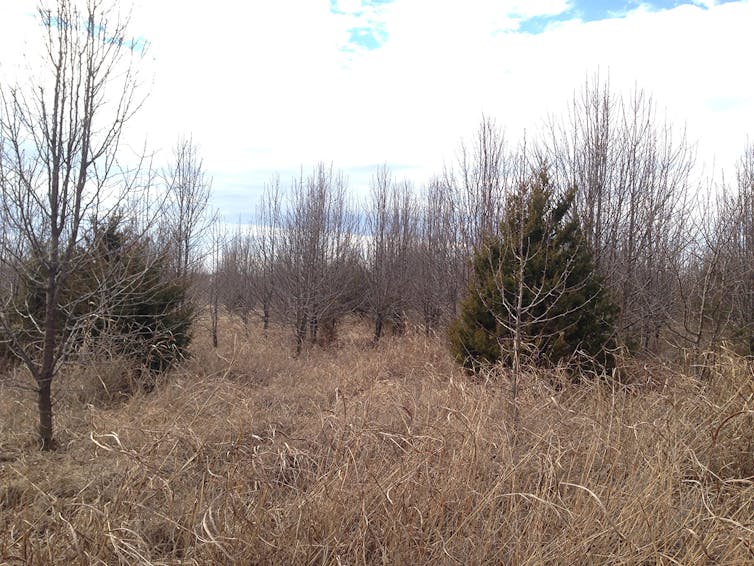
When people think of spring, they often picture flowers and trees blooming. And if you live in the U.S. Northeast, Midwest or South, you have probably seen a medium-sized tree with long branches, covered with small white blooms – the Callery pear (Pyrus calleryana).
For decades, Callery pear – which comes in many varieties, including “Bradford” pear, “Aristocrat” and “Cleveland Select” – was among the most popular trees in the U.S. for ornamental plantings. Today, however, it’s widely recognized as an invasive species. Land managers and plant ecologists like me are working to eradicate it to preserve biodiversity in natural habitats.
As of 2023, it is illegal to sell, plant or grow Callery pear in Ohio. Similar bans will take effect in South Carolina and Pennsylvania in 2024. North Carolina and Missouri will give residents free native trees if they cut down Callery pear trees on their property.
How did this tree, once in high demand, become designated by the U.S. Forest Service as “Weed of the Week”? The devil is in the biological details.
A quasi-perfect tree
Botanists brought the Callery pear to the U.S. from Asia in the early 1900s. They intentionally bred the horticultural variety to enhance its ornamental qualities. In doing so, they created an arboricultural wunderkind. As The New York Times observed in 1964:
“Few trees possess every desired attribute, but the Bradford ornamental pear comes unusually to close to the ideal.”
Modern varieties of Callery pear produce an explosion of white flowers in springtime, followed by deep green summer foliage that turns deep red and maroon in autumn. They also are very tolerant of urban soils, which can be highly compacted and hard for roots to penetrate. The trees grow quickly and have a rounded shape, which made them suitable for planting in rows along driveways and roadsides.

During the post-World War II suburban development boom, Callery pear trees became extremely popular in residential settings. In 2005 the Society of Municipal Arborists named the “Chanticleer” variety the urban street tree of the year. But the breeding process that created this and other varieties of Callery pear was producing unexpected results.
Cloning to produce an American original
To ensure that each Callery pear tree had bright blooms, red foliage and other desired traits, horticulturists created identical clones through a process known as grafting: creating seedlings from cuttings of trees with the desired characteristics.
This approach eliminated the messy complexity of mixing genes during sexual reproduction and ensured that when each tree matured, it would have the characteristics that homeowners desire. Every tree of a specific variety was a genetically identical clone.
Grafting also meant Callery pear trees could not make fruits. Some fruit trees, such as peaches and tart cherries, can fertilize their flowers with their own pollen. In contrast, Callery pear is self-incompatible: pollen on an individual tree cannot fertilize flowers on that tree. And since all Callery pears of a specific variety planted in a neighborhood would be identical clones, they would effectively be the same tree.
If a tree can’t produce fruits, it can’t disperse into natural habitats. Gardeners and landscapers thought it was perfectly safe to plant Callery pear near natural habitats, such as prairies, because the species was trapped in place by its reproductive biology. But the tree would break free from its isolation and spread seeds far and wide.
The great escape
University of Cincinnati botanist Theresa Culley and colleagues have found that as horticulturalists tinkered with Callery pears to produce new versions, they made the individuals different enough to escape the fertilization barrier. If a neighborhood had only “Bradford” pear trees, then no fruits could be produced – but once someone added an “Aristocrat” pear to their yard, then these two varieties could fertilize each other and produce fruits.
When Callery pear trees in gardens and parks started depositing seeds in nearby areas, wild populations of the trees became established. Those wild trees could pollinate one another, as well as neighborhood trees.
In today’s landscape, Callery pear is astonishingly fertile. The prolific flowering that horticulturists intentionally bred into these varieties now yields tremendous crops of pears each year. Although these little pears are generally not edible by humans, birds feed on the fruit, then fly away and excrete the seeds into natural habitats. Callery pear has become one of the most problematic invasive species in the eastern United States.
A thorny problem
Like other invasives, Callery pears crowd out native species. Once Callery pear seedlings spread from habitat edges into grasslands, they have advantages that allow them to dominate the site.
In my research lab, we have found that Callery pear leafs out very early in spring and drops its leaves late in fall. This enables it to soak up more sun than native species. We also have discovered that during invasion, these trees alter the soil and release chemicals that suppress the germination of native plants.
Callery pear is highly resistant to natural disturbances. In fact, when my graduate student Meg Maloney tried to kill the trees by using prescribed fires or applying liquid nitrogen directly to stumps after cutting the trees down, her efforts failed. Instead, the trees sprouted aggressively and seemingly gained strength.
Once Callery pear has escaped into natural areas, its seedlings produce very sharp, stiff thorns that can puncture shoes or even tires. This makes the trees a menace to people working in the area, as well as to native plants. Another nuisance factor is that when Callery pears bloom, they produce a strong odor that many people find unpleasant.
Currently, directly applying herbicides is the only known control for a Callery pear invasion. But the trees are so successful at spreading that poisoning their seedlings may simply create space for other Callery pear seedlings to establish. It is unclear how habitat managers can escape a confounding ecological cycle of invasion, herbicide application and re-invasion.

Banned but not gone
In response to work by the Ohio Invasive Plants Council and other experts, Ohio has taken the extraordinary step of banning Callery pear to thwart its ecological invasion into natural habitats. But the trees are common in residential areas across the state and have established vigorous populations in natural habitats. Ecologists will be working well into the future to maintain openness and biodiversity in areas where Callery pear is invading.
In the meantime, homeowners can help. Horticulturists recommend that people who have a Callery pear on their property should remove it and replace it with something that is not an invasive species. Few trees possess every desired attribute, but many native trees have visually attractive features and will not threaten ecosystems in your region.
Ryan W. McEwan does not work for, consult, own shares in or receive funding from any company or organisation that would benefit from this article, and has disclosed no relevant affiliations beyond their academic appointment.
This article was originally published on The Conversation. Read the original article.







